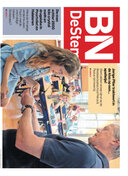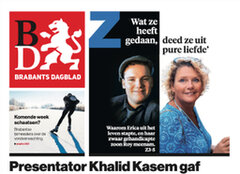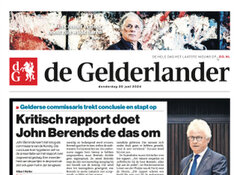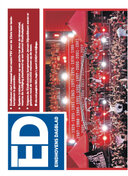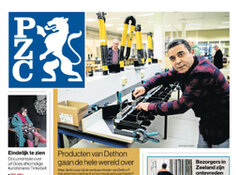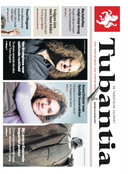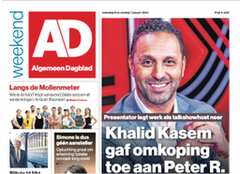Private mail that arrived too late led to a series of stories about the failure of PostNL
How the newspaper helped solve a postal crisis
What started at the home of PZC reporter Sven Remijnsen with his letters not being delivered, led to a series of ten stories about a postal crisis in Zeeland. It ended with a conclusion that surprised even the experienced journalist
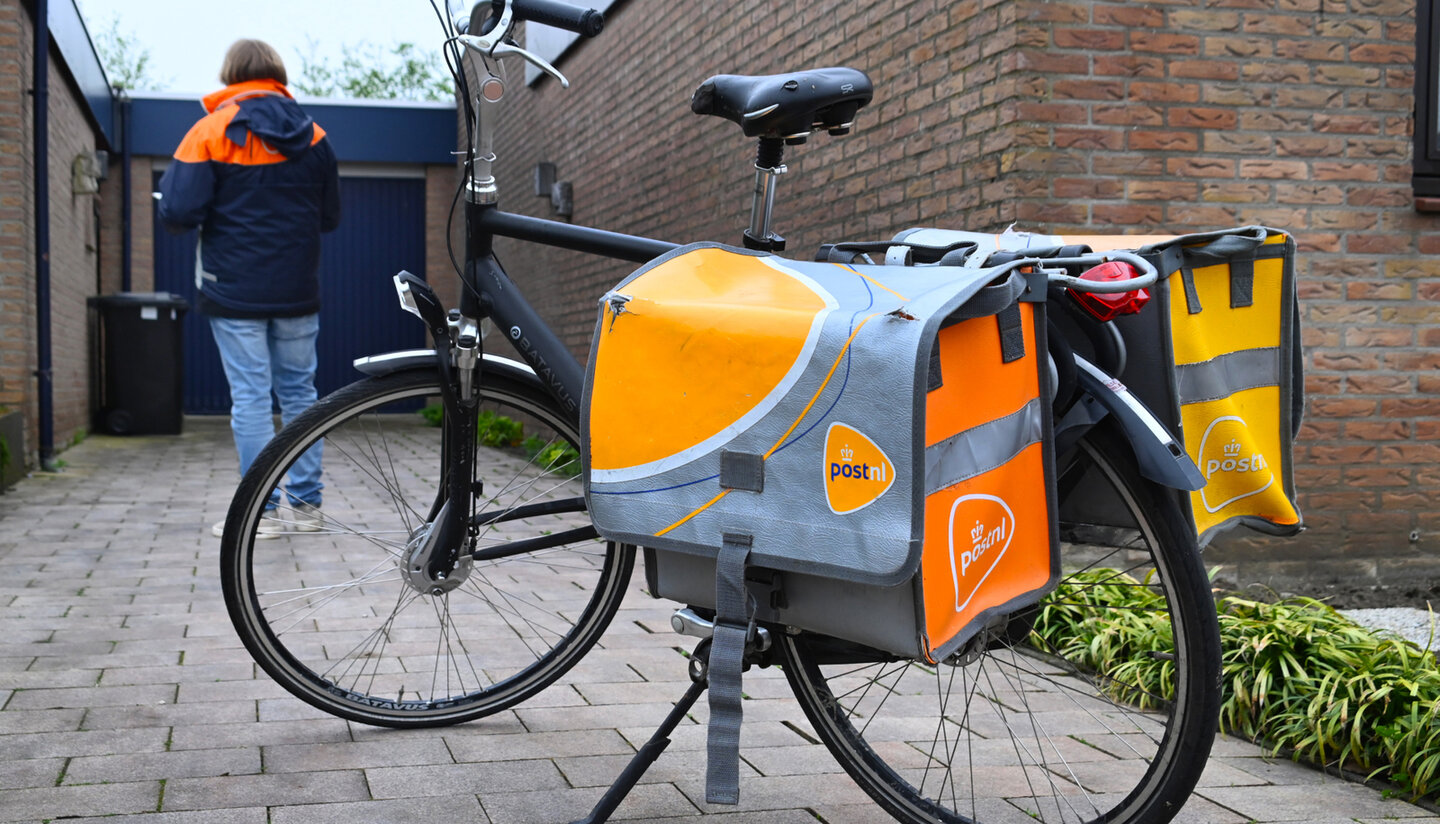
E
arly 2024, at his home in Kloetinge – a village in the Municipality of Goes – PZC reporter Sven Remijnsen saw in the PostNL app that he was about to receive a large stack of letters. Virtually, that is, because the letters were never delivered. “About 15 letters, including mail from the GP, the hospital, school... pretty important things.”
Remijnsen tipped off a colleague covering the Goes area. Upon enquiry, it quickly became clear that almost the entire village was suffering under the lousy postal service. Birthday cards arrived far too late, so did bills, a funeral card arrived four days after the cremation... PostNL’s response? Remijnsen has heard it over and over again. Staff shortages, annoying and our apologies.
Remijnsen had the feeling that there was more going on and called on PZC readers to share their experiences via PZC.nl. “That’s when things really started to happen, I received dozens of responses from all over Zeeland. And not because the TV guide came a day too late. No, serious problems. People who missed their hospital appointment. Or a funeral because the mail arrived too late or not at all.
The reporter came into contact with a funeral director, for example, who had been struggling for months because bereavement mail wasn’t arriving. “He ended up driving around Zeeland himself to deliver the cards. I thought: if a funeral director has to deliver his own mail, that’s a whole new story.”
If a funeral director has to deliver his own mail, that’s a whole new story
Remijnsen published that story (‘Postbezorging in Zeeland is een drama’) in February, including PostNL’s response: staff shortages, annoying, apologies. And there was a story on how the postal worker’s status has changed; once a respected person in the towns and villages of Zeeland, now someone who is blamed for the poor delivery.
This once again resulted in many reactions. The Lower House asked critical questions of the Minister of Economic Affairs about the postal crisis exposed by PZC in Zeeland.
Postal workers also made their voices heard. They were fed up with the bad press about their work. Remijnsen talked to them, joined them on their rounds and discovered something surprising. The poor mail delivery service, which PostNL blamed on staff shortages, appeared to have a very different cause.
The company introduced new routes in the summer of 2023. The routes were introduced as ‘logical delivery’ and had been developed with the help of AI. According to the postal workers, things have gone wrong since then. Neighbourhoods have become much larger and the routes are not logical, resulting in a lot of time being lost. These are problems that the postal workers reported to their managers, but nothing was done with their complaints. That is, until PZC wrote about what was going on.
Stories shed light
Looking back, Remijnsen is particularly proud that his stories shed light on the issues faced by the postal workers. “By giving people at the bottom of the labour market a voice it has become clear where the problem lies. That would never have been possible through PostNL spokespersons.”
The Lower House asked critical questions
The delivery of mail in Zeeland is now back to how it should be. Remijnsen shows us an email that he received recently from one of the postal workers in his stories: “The management board of PostNL came to Zeeland to listen to us. This would never happened were it not for the stories in PZC. We are now allowed to arrange the routes with more of our own input and problem neighbourhoods are being tackled. Things are much better than earlier this year.”
Ronald van Geenen
Editor-in-chief of PZC

Fast news can also be too fast
Just like other regional news media, PZC’s editorial team works at different speeds. On the one hand slow, in-depth journalism and on the other hand fast news such as 112 reports. A fatal accident on the Brouwersdam taught the editorial team that you can also be too fast.
A horrific accident on the N57 between Scharendijke and Ouddorp. A 38-year-old man was killed on the Brouwersdam after colliding head on with an oncoming vehicle. During the trial earlier this year, it appeared that the driver of the oncoming vehicle had fallen asleep at the wheel. Very soon after the accident, PZC’s online editorial team received the first reports. Several 112 news photographers provided images. Less than an hour after the accident, the first report with photos had been posted online.
What the editorial team did not know at the time was that the victim’s wife was reading the news about the accident on the PZC app. She recognised the car, but also the location because that was her husband’s daily route to and from his work. The sum total of these facts was the start of a nightmare for her. The coverage of this accident and the contact with next of kin were the editorial team’s starting point for discussions on the speed of reporting 112 news. We now look much more critically at the timing and the images that we use.
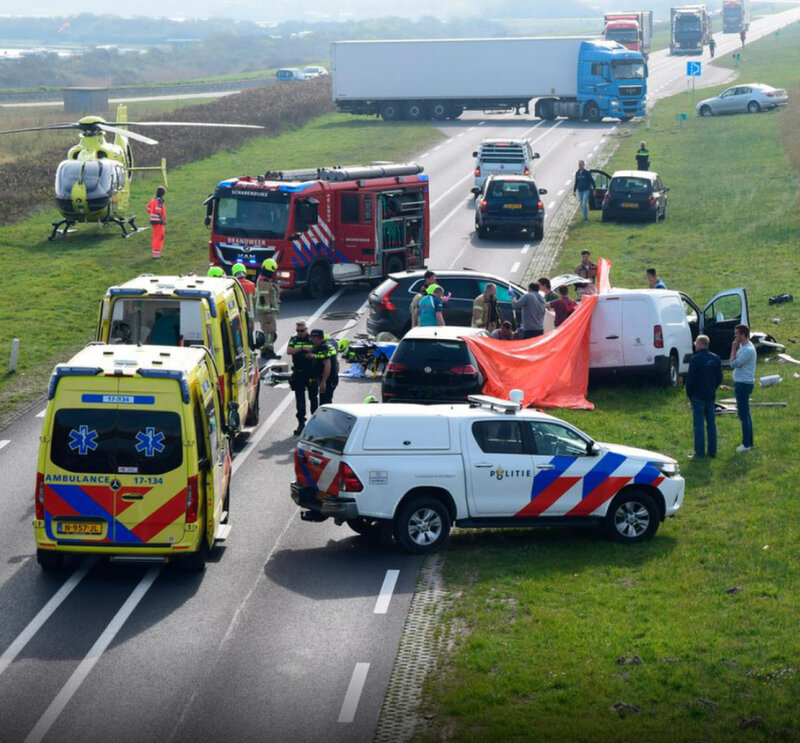
Readers of the future
N
othing is more fun than young people at the editorial offices of the PZC because they are our readers of the future. Instagram, Twitter, Snapchat, TikTok and YouTube are the windows to the world for young people. In the past, they would have read newspapers or had a subscription at that age. This no longer applies to Gen Z. This means that PZC has to be creative to reach them. Every year we receive requests from students who want to do a taster placement or schools who want to give students a taste of journalism. We always say YES! We also offer ‘career speed dating’ and give guest lectures at schools.
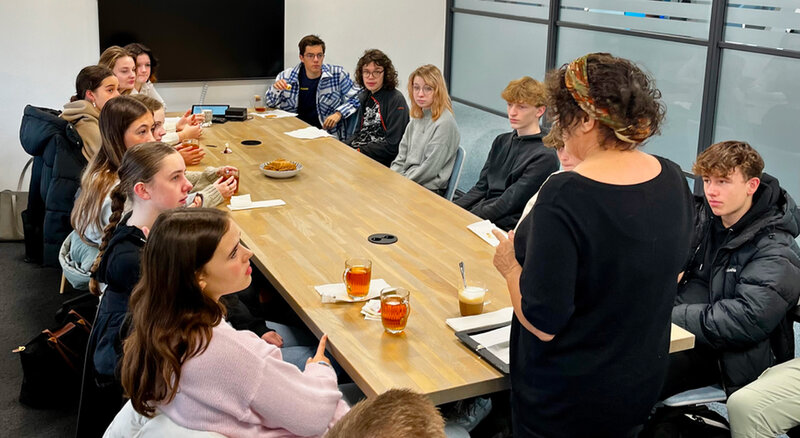
We did this at Sint Jozef school in Vlissingen, for example, where we talked about facts and opinions, the reliability of sources, fake news and the role of news. Children taking part in the Petje af project in Goes came to look around our head office after they had had a guest lesson on journalism.
They say that they get their news from Instagram, Snapchat or TikTok. But there is no such thing as free, independent news. Influencers are paid to promote products. Journalists get a salary and don’t have to cut deals. As long as people pay for news, we can remain independent.

ADR Nieuwsmedia zit in de haarvaten van Nederland
Algemeen Dagblad en de zeven regionale titels van DPG Media vormen één groep: ADR Nieuwsmedia. Binnen deze grootste nieuwsorganisatie van Nederland wordt nauw samengewerkt. Hoe gebeurt dat?
We vragen het onze abonnees in Gelderland, Brabant, Twente of Zeeland elk jaar opnieuw, maar we kennen het antwoord: zij lezen onze sites, apps en kranten vooral vanwege het regionale nieuws. Dat geldt trouwens niet alleen voor lezers uit die genoemde streken. Ook de AD-lezers in en rond Den Haag, Utrecht of Rotterdam zetten ‘lokaal nieuws’ bovenaan hun lijstje van favoriete artikelen. Meteen daaronder staat vaak hun favoriete voetbalclub.
Het enorme belang dat abonnees stellen in nieuws uit hun eigen buurt deed kranten decennia geleden besluiten zich te concentreren op de beste regionale verslaggeving. Voor zaken als binnenlandse politiek, buitenland, economie, cultuur of topsport bundelden ze de krachten in gemeenschappelijke persdiensten. Zo ontstonden de Zuid-Oost Pers, de GPD en de Wegener Persdienst. Die laatste persdienst verdween toen DPG Media tien jaar geleden de regionale kranten van Wegener kocht. AD en de zeven regionale kranten werken sindsdien samen in ADR Nieuwsmedia.
Samenwerken
Een centrale redactie met 200 journalisten van het AD en de samenwerkende titels in de regio, verzorgt vanuit Rotterdam het (inter)nationale nieuws. Zodat De Gelderlander zich kan richten op de eigen provincie en de PZC zich alleen bezig hoeft te houden met Zeeland.
De stroom nieuws gaat niet alleen van Rotterdam naar de regio, maar ook omgekeerd. Als er in Eindhoven of Enschede iets groots gebeurt, delen het ED en Tubantia dit nieuws onmiddellijk met het AD en de andere regionale titels. Het maakt ADR, zeker buiten de Randstad, tot een van de snelste nieuwsorganisaties en zeker de meest wijdvertakte. Want ADR beschikt over ruim 800 journalisten en een netwerk van lokale correspondenten. ADR zit in de haarvaten van Nederland.
Leidt dit tot eenheidsworst? Allerminst. Het nieuws uit Oost-Nederland beheerst de homepage van de Stentor, dat uit de regio Breda de voorpagina van BN DeStem – en zo verder. De lay-out van ADR-kranten en -online-platforms komen overeen, de inhoud verschilt sterk, want elke titel maakt eigen, onafhankelijke keuzes. De eigenheid en uniciteit van de unieke regionale verslaggeving bepaalt immers het succes van een titel. Ruim 900.000 abonnees en bijna vijf miljoen online bezoekers zijn er dagelijks blij mee.
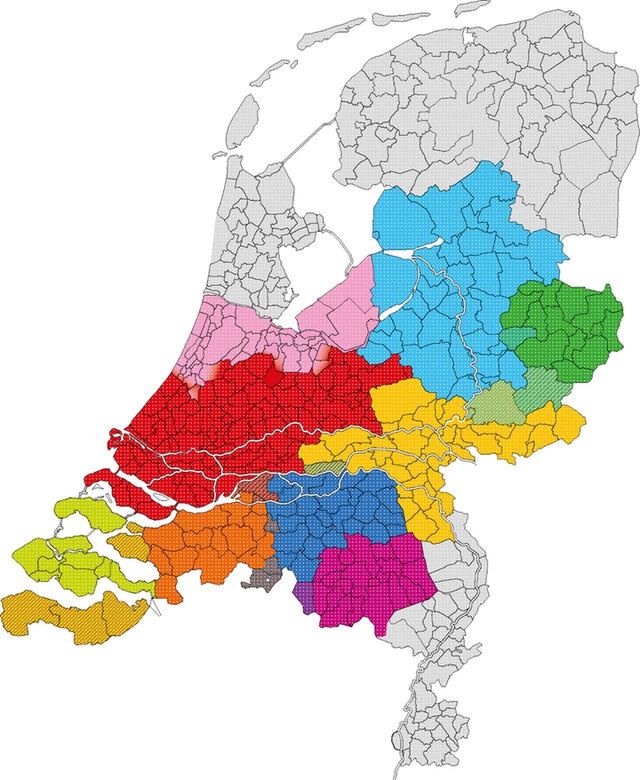
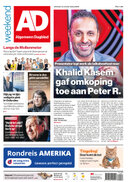
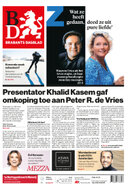
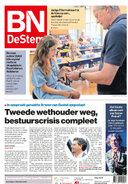
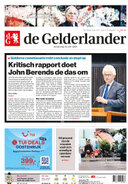
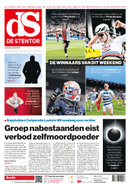
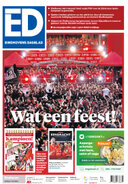
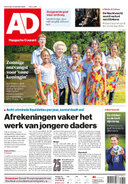
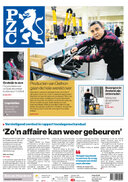
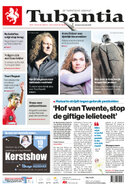
De regionale titels in Nederland
Ad Regio
de Stentor
Tubantia
De Gelderlander
Brabants Dagblad
Eindhovens Dagblad
BN DeStem
PZC
AD Landelijk
Kies jouw locatie
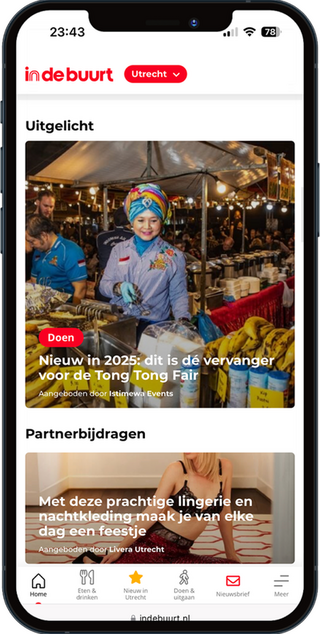
indebuurt.nl
Sinds een aantal jaren maakt ook indebuurt.nl onderdeel uit van ADR. Het gratis platform richt op alles wat een stad leuk maakt voor haar inwoners en is sterk gericht op het bieden van service. Zo geeft indebuurt.nl bezoekers informatie over nieuwe winkels, over uitgaan, activiteiten in de stad en bijzondere plekken. Inwoners worden uitgenodigd de redactie van tips te voorzien, of vrijblijvend teksten, foto’s of video’s aan te leveren. De makers van ‘indebuurt’ hebben de ambitie om gebruikers nauwer bij het stadsleven te betrekken.
indebuurt.nl is actief in 34 steden, vooral in plaatsen waar ook ADR-titels actief zijn. Artikelen van indebuurt.nl staan daarom ook op de sites en apps van de regionale titels van ADR en enkele malen per week in de gedrukte kranten. Per maand bezoeken ruim 2,5 miljoen mensen een van de secties. Daarmee staat ‘indebuurt’ in de top 10 van nieuwssites in Nederland.
Journalistiek & techniek
ADR-redacties maken gebruik van technische innovaties op het gebied van automatisering en kunstmatige intelligentie (AI). Het gebruik van spellingscorrectie is bijvoorbeeld al sinds jaar en dag ingeburgerd. Het is per definitie een journalist die bepaalt welk onderwerp wordt opgepakt en of wat er wordt gepubliceerd. AI wordt – nu nog experimenteel – gebruikt om teksten van bijvoorbeeld persberichten snel samen te vatten of tot een kort artikel te verwerken. Daarnaast kan AI ook suggesties doen voor spelling, grammatica, koppen en ideeën voor verhalen. De journalist bepaalt of suggesties worden overgenomen. We noemen deze werkwijze het mens-machine-mens-principe.
De redactie gebruikt automatisering het meest voor serviceberichten, zoals lokale weerberichten voor alle 342 gemeenten in Nederland. Als de verwachting is dat de temperatuur daalt van 2 naar -2, staat er een zin klaar die deze data-informatie vertaalt naar bijvoorbeeld ‘het gaat vriezen’ of ‘het kwik daalt onder nul’. De redactie vermeldt bij dit soort berichten dat ze automatisch zijn samengesteld. Automatisering kan ook worden gebruikt om op basis van data voor alle gemeenten in Nederland berichten te maken over bijvoorbeeld de afname van het gebruik van zonnepanelen of de toename van winkelleegstand. Het is een gespecialiseerde journalist die hiervoor data verzamelt en een basisbericht schrijft, eventueel aangevuld met andere bronnen. De techniek helpt ons om daar voor elke gemeente een eigen versie van te maken.
Cijfers
achter AD en de regionale titels
Gemiddeld dagelijks bereik
Het dagelijks bereik is een veelgebruikte indicatie van de impact die digitale journalistiek heeft. Maandbereik wordt ook weergegeven in de nationale monitors, maar daarin spelen eenmalige bezoekers van de sites een relatief grote rol.
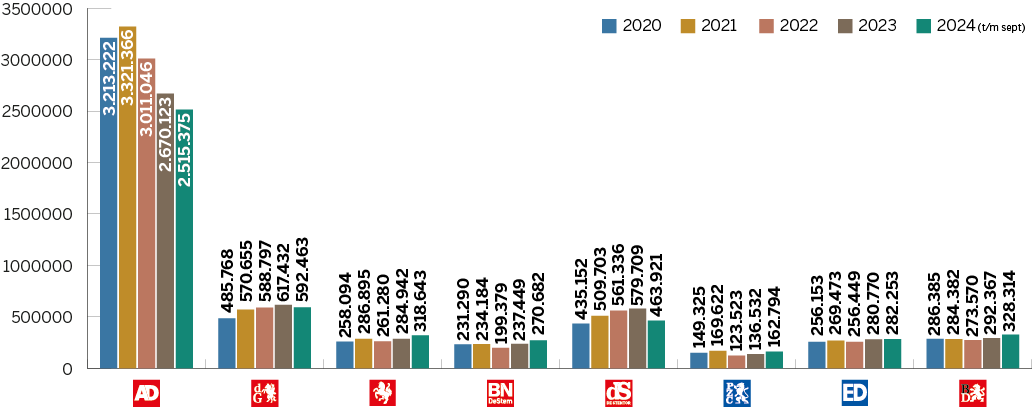
Journalisten in vaste dienst in 2024
Dit geeft de omvang van de redactie weer, omgerekend in voltijds banen (fte). Het zijn zowel de verslaggevers als de chefs, eindredacteuren, vormgevers, beeldredacteuren, video- en podcastmakers en onlineredacteuren. Om het beeld zuiver te houden zijn de freelance journalisten niet opgenomen. Die leveren eveneens een belangrijke bijdrage in de vorm van artikelen, columns, beeld, audio en video. Het zijn er soms honderden per titel. Aantal en werkzaamheden fluctueren van jaar tot jaar.

Meer info
Gemiddeld aantal unieke artikelen per dag
Dit is de hoeveelheid eigen artikelen die elke redactie produceert, van groot tot klein. De meeste redacties publiceren meer dan dat: bijvoorbeeld artikelen van de centrale redactie in het geval van de regionale kranten, of (in België) artikelen van collega-titels die worden doorgeplaatst. Die zijn niet meegeteld, net zo min als de kleine lokale berichten die automatisch worden gemaakt (zoals het weer en 112-berichten), of de doorgeplaatste artikelen van ‘Indebuurt’. Zo ontstaat het zuivere cijfer van wat de eigen redactie dagelijks maakt.

Meer info
Betalende abonnees
Dit is de som van papieren, digitale en hybride abonnementen. Het is het gemiddelde aantal over het desbetreffende jaar.

Rapportcijfers van eigen abonnees
Dit cijfer wordt gegeven door deelnemers aan een jaarlijks lezersonderzoek dat voor de meeste titels wordt gehouden.

Vertrouwenscijfer uit onderzoek
Dit cijfer is afkomstig uit recent onderzoek naar merkvertrouwen in opdracht van DPG Media. Daarbij geeft een algemeen publiek, dus niet alleen abonnees of bezoekers, vertrouwen in verschillende nieuwsmedia aan op een schaal van 0 (helemaal niet betrouwbaar) tot 10 (uiterst betrouwbaar). Daarnaast worden abonnees uitgesplitst, die hun titel doorgaans meer dan gemiddeld vertrouwen. Deze onderzoeksmethode en de uitkomsten komen overeen met die van het jaarlijkse Digital News Report van het Reuters Institute in Oxford. De Nederlandse en Vlaamse gemiddelde vertrouwenscijfers liggen in die monitor hoger dan die van nieuwsmedia in de omringende Europese landen.
Algemeen publiek
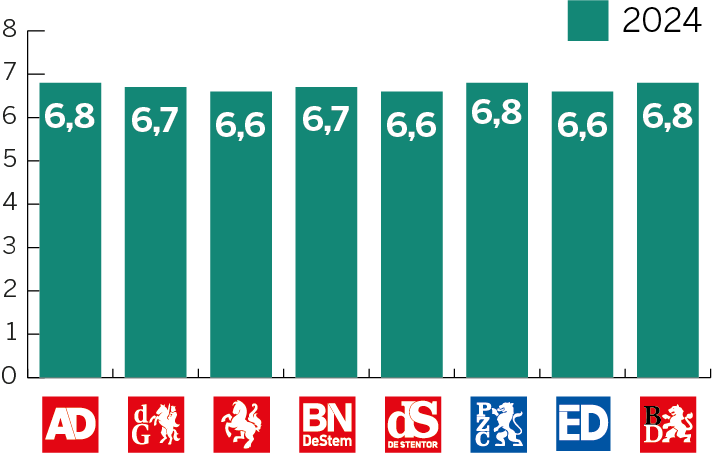
Abonnees
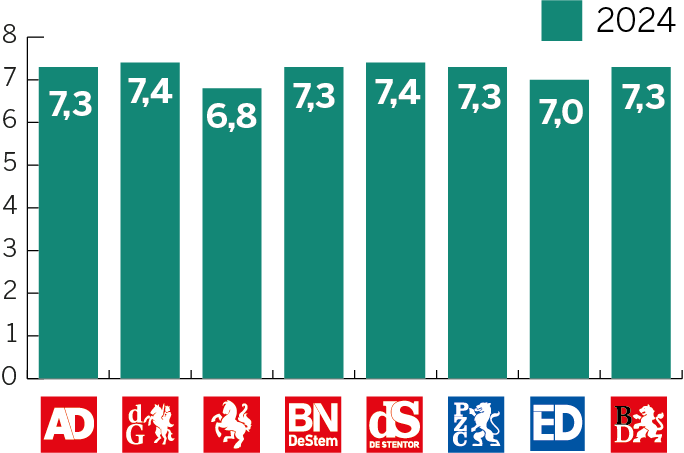
Aantal podcastafleveringen per jaar van alle titels
Deze cijfers geven aan hoeveel podcasts er door de verschillende titels zijn ontwikkeld.
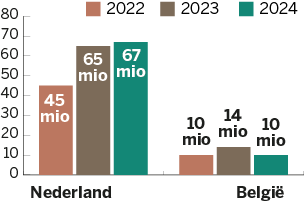
Gemiddeld aantal unieke video's per dag
Deze cijfers geven aan hoeveel video's er door de verschillende titels zijn ontwikkeld.
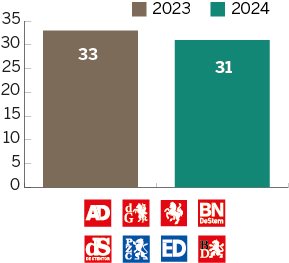
Dagelijks bereik
Gemiddeld dagelijks bereik
Het dagelijks bereik is een veelgebruikte indicatie van de impact die digitale journalistiek heeft. Maandbereik wordt ook weergegeven in de nationale monitors, maar daarin spelen eenmalige bezoekers van de sites een relatief grote rol.

Betalende abonnees
Betalende abonnees
Dit is de som van papieren, digitale en hybride abonnementen. Het is het gemiddelde aantal over het desbetreffende jaar.

Rapportcijfer van abonnees
Rapportcijfers van eigen abonnees
Dit cijfer wordt gegeven door deelnemers aan een jaarlijks lezersonderzoek dat voor de meeste titels wordt gehouden.

Journalisten in vaste dienst
Journalisten in vaste dienst in 2024
Dit geeft de omvang van de redactie weer, omgerekend in voltijds banen (fte). Het zijn zowel de verslaggevers als de chefs, eindredacteuren, vormgevers, beeldredacteuren, video- en podcastmakers en onlineredacteuren. Om het beeld zuiver te houden zijn de freelance journalisten niet opgenomen. Die leveren eveneens een belangrijke bijdrage in de vorm van artikelen, columns, beeld, audio en video. Het zijn er soms honderden per titel. Aantal en werkzaamheden fluctueren van jaar tot jaar.

Meer info
Unieke artikelen per dag
Gemiddeld aantal unieke artikelen per dag
Dit is de hoeveelheid eigen artikelen die elke redactie produceert, van groot tot klein. De meeste redacties publiceren meer dan dat: bijvoorbeeld artikelen van de centrale redactie in het geval van de regionale kranten, of (in België) artikelen van collega-titels die worden doorgeplaatst. Die zijn niet meegeteld, net zo min als de kleine lokale berichten die automatisch worden gemaakt (zoals het weer en 112-berichten), of de doorgeplaatste artikelen van ‘Indebuurt’. Zo ontstaat het zuivere cijfer van wat de eigen redactie dagelijks maakt.

Meer info
Vertrouwenscijfer uit onderzoek
Vertrouwenscijfer uit onderzoek
Dit cijfer is afkomstig uit recent onderzoek naar merkvertrouwen in opdracht van DPG Media. Daarbij geeft een algemeen publiek, dus niet alleen abonnees of bezoekers, vertrouwen in verschillende nieuwsmedia aan op een schaal van 0 (helemaal niet betrouwbaar) tot 10 (uiterst betrouwbaar). Daarnaast worden abonnees uitgesplitst, die hun titel doorgaans meer dan gemiddeld vertrouwen. Deze onderzoeksmethode en de uitkomsten komen overeen met die van het jaarlijkse Digital News Report van het Reuters Institute in Oxford. De Nederlandse en Vlaamse gemiddelde vertrouwenscijfers liggen in die monitor hoger dan die van nieuwsmedia in de omringende Europese landen.
Algemeen publiek
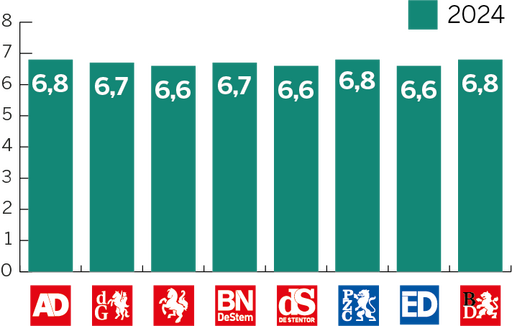
Abonnees
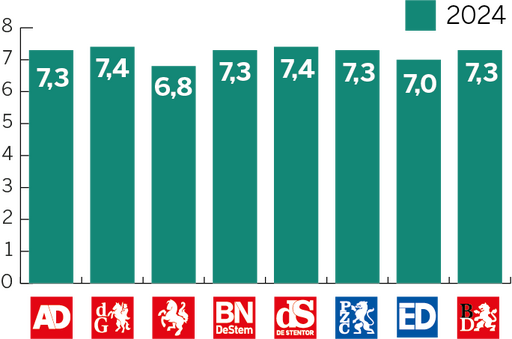
Aantal podcastafleveringen
Aantal podcastafleveringen per jaar van alle titels
Deze cijfers geven aan hoeveel podcasts er door de verschillende titels zijn ontwikkeld.

Aantal unieke video's
Gemiddeld aantal unieke video's per dag
Deze cijfers geven aan hoeveel video's er door de verschillende titels zijn ontwikkeld.


